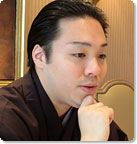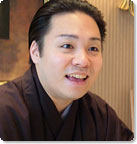- It is unfortunate that in Japan today there is more attention on classical ballet and riverdance than there is on Nihon buyo (traditional Japanese dance). I think many Japanese don’t even know the difference between Kabuki dance and traditional Japanese dance. Could you give us a beginner’s definition of the two?
- Like the three characters that make up the word Kabuki in Japanese, Kabuki consists of song (poetry), dance and technique (acting, action). When Izumo no Okuni began Kabuki there was the influence of Noh theater that probably made the dance aspect dominant over the theatrical aspect. As Kabuki evolved after that, spoken parts were added and female parts [acted by men] emerged, the shamisen accompaniment was added until it reached the form of Kabuki dance we know today in the Edo Period. But originally, in Okuni’s era, Kabuki was dance. When Nagauta story recitation and shamisen music such as Kiyomoto became popular and Kabuki gained popularity as a result, there would naturally be a lot of amateurs wanting to learn the art. That in turn led to something close to Kabuki dance being taught as a form of small-scale “chamber” entertainment. This development brought the need for people to teach the amateurs. While Kabuki is a strictly male art, I think this need led to a role for talented women dance teachers and their presence gave birth eventually to what we know as Nihon buyo today.
- When you are asked what your profession is, do you call yourself a buyo-ka (dancer) or a furitsuke-shi (choreographer)?
- A furitsuke-shi , a choreographer. I am 25 years old now, so I call myself the No. 1 young choreographer. There are no other young [Kabuki] choreographers (laughs). In our world, young means someone around 50. And, since there are no [Kabuki] choreographers in their 30s or 40s, I’m not really the “No. 1” young choreographer but the “only one” young choreographer (laughs).
- It would seem that during the 400-year history of Kabuki the actors have created and passed down the movements ( kata ) that we see in Kabuki today. So, what is the role of the furitsuke-shi (choreographer)?
- I think most people have a misunderstanding concerning this. The kata of Kabuki—in other words the choreography of Kabuki—is not handed down through the families of Kabuki actors but through our families of Nihon buyo . For example, if the Kabuki actors are going to be performing Kyoganoko Musume Dojoji at the Kabuki-za theater next month, the actors come to practice at the Kanjuro studio, because the Dojoji choreography belongs to the Kanjuro family. After we teach them the movements, the actors from Kabuki families may go back home and their fathers will tell them, “This is how we did it in our day.” In other words, our role as the choreographer families is to teach them the basic movements of the dances.
- Do you teach the dances differently to different actors?
-
Yes, it differs. Each actor has his own different physique and different mannerisms, so we choreograph differently for each actor. My grandfather, Kanjuro VI, used to say, “There is no one single form. You should make your own forms. That is the job of a
furitsuke-shi
.” In other words there are no forms or movements that are set in stone.
If a 25-year-old actor danced exactly the same way as a 65-year-old actor, the audience would surely think, “Why is he moving so slowly?” So, we add movements that make the younger actor look good. If the actor is 70, you choreograph in a way that he can move slowly and still look good with a mellow flavor. In short, the job of the furitsuke-shi is to choreograph in a way that brings out the best in each actor and makes him look like a great dancer.
Of course, you have to know the personality and the unique mannerisms of the individual actors. Personalizing the choreography to fit the mannerisms of the individual actors was something that my grandfather started. Apparently, it started when he was choreographing for a production of the famous Kabuki play Masakado Shinobiyoru Koi ha Kusemono by Uzaemon VI, who was a famously handsome actor, and Nakamura Kikugoro, another famous actor. Despite the presence of these two popular actors in a well-loved play, the audience was apparently not responding well. So, Uzaemon came to my grandfather and said, “Your choreography is to blame. I want you to change the choreography to something that will get some applause.” My grandfather said, “All right, I’ll have something ready by tomorrow.” But Uzaemon was angry and he said, “You do it right here and now, or you can drop dead!” My grandfather didn’t know what to do, but he remembered at that moment that Uzaemon had a particular habitual gesture of moving his hands back and forth around his chest. So, my grandfather worked that gesture into the choreography and at the next performance that dance drew big applause. From then on, Uzaemon put complete faith in my grandfather. - Did your grandfather, Kanjuro VI also teach you dance?
-
My grandfather was already 80 when I was born. He was fond of me and played with me a lot when I was little, but my actual teacher was my mother. My first stage appearance was at the age of two and a half, but it wasn’t a case of my being forced to dance. It happened naturally because of the environment where everyone in our household danced. When I was in elementary school, instead of playing with my classmates after school, I would usually come home and practice dancing.
When I came home, my grandfather would play with me, creating stage scenes using little dolls. They weren’t really dolls, though, just the little plastic Lego figures (laughs). My grandfather would hum the shamisen accompaniment as I moved the figures. From playing in that way I naturally learned the stories of the kabuki plays and the words of the songs. And, as we played, he also told me the old folk tales and about the great Kabuki actors. Those things he taught me have become important and useful for me in my work today.
I still use Lego figures when I am thinking up choreography. When planning the movements for scenes involving a lot of people, it is hard to keep all the actors positions in your head at once. So, I past the actor’s names on the Lego figures and move them around as I think. Sometimes I even take them to the rehearsals and use them to explain things to the actors. I can imagine that onlookers might think it strange, though, to see these adults playing with Lego figures (laughs). - When did you first work as a Kabuki furitsuke-shi ?
-
It was in February of my first year in high school, I think. I went with my mother when she was working with a Kabuki company on tour in one of Japan’s regional cities. The day before the first performance we were having dinner and my mother said, “I’d like to come to a place like this when I’m not working.” Hearing that, the Kabuki actor Nakamura Tomijuro said, “Why don’t you take tomorrow off and let your son fill in for you.” That surprised me, but my mother said, “Well, if it’s all right with you, I think I’ll do that.”
Then, in February of the next year I went with my mother as furitsuke-shi for a Kabuki tour in Italy. That was my first real job in that role, but it wasn’t until I was 20 that I worked independently without my mother. - Besides working with the actors in rehearsals, do Kabuki furitsuke-shi also have a role when the actual productions go on stage?
-
You can think of the job of a Kabuki
furitsuke-shi
as being similar to that of a director in theater. For the dance scenes, the
furitsuke-shi
has to know not only the actors’ movements but also everything about the lighting, large and small props, the costumes and wigs and also the music. Bringing all these aspects together is another part of the job of a
furitsuke-shi
.
In the case of Kabuki, there are only three days before the start of performances when all the actors come together to rehearse on stage. Until then, the actors, shamisen and drum performers all practice separately on their own. It isn’t until three days before the opening that everyone comes together for the first time on the stage to rehearse with the actual props and lighting and other elements that will be used. At that time, it is the furitsuke-shi who will give instructions about things like what sound or music should be used when the curtain opens and where the actors should leave and return to the stage from during quick-change scenes and what part of the accompaniment the shamisen should be playing at those moments. All this and things like deciding on the processes to be used for different scenes are the responsibility of the furitsuke-shi . If I think that the size of a prop doesn’t fit the physique of an actor and it is making it difficult for him to move properly, it is my job to negotiate with the prop people and get them to change the size of that prop. And, if an actor makes a request concerning the music or lighting, for example, it is my job to get the people in charge of those aspects to make the necessary adjustments. - I had thought that the furitsuke-shi was only responsible for the dance movements, but from what you say I realize that you also play the role of director and stage manager.
-
Yes. But, what is different from the role of a modern theater director is that in Kabuki it is the actors who do the final decision-making concerning their own parts. The actor always comes first, and my job is to support the actor from behind the scenes by deciding how best to answer the actor’s requests and think about how to make the actors look as good as possible on stage.
To do this, it is not enough just to know about the dance movements. I have to be knowledgeable about the lighting, the set equipment, the costumes, the music, everything, and I have to be able to get the cooperation of the people in charge in all these areas. Often it is very difficult and problems emerge, but I still love this job of the furitsuke-shi tremendously. Even with the old traditional repertoire, I think about places to change to make it more interesting and get the audiences to appreciate it more. I work on these ideas over and over and then I bring them to the stage. I am in a position where I can have these ideas I’ve worked out in my head actually performed by great actors and win the applause of the audience when they are successful. I can say that I want a drum beat at a certain climactic moment and it will be there. This is a joy that only people involved in the creative process can know. - Recently there have been theater directors like Ninagawa Yukio who have created a lot of interest by directing Kabuki.
-
In the Kabuki world, the
furitsuke-shi
is only one of the backstage people, and my policy is that we should remain backstage and never come out in the spotlight. It is enough for me if I can just help the actors look better. The important thing is to be trusted, by the actors, the producer, the musicians and the stage people; to be a person that they know will help to bring things together. There is nothing that says the actors have to come to me for choreography. If they don’t trust me and believe in my work, they will stop coming to me.
In the real professional world, age and name have no meaning. It all depends on your achievements. I succeeded to the Kanjuro name on the 13th anniversary of my grandfather’s death. But, jobs don’t come to me just because I am now the head of the Fujima school of traditional Nihon buyo . Although my mother and I are the only two who are called furitsuke-shi for Kabuki dance, there are plenty of other masters of Nihon buyo , and if I don’t deliver with good choreography, the actors can go to other people.
You can’t give proper direction out there on a Kabuki stage unless you have complete knowledge of Kabuki, and I don’t want to sound like I’m bragging, but I did an awful lot of studying to get where I am now. From middle school I was studying Nagauta recitation, shamisen and Japanese tsuzumi drum and I was allowed the privilege of performing with the musicians at the Kabuki-za theater in the misuuchi (musician’s pit on the right of the stage). Performing there I learned to see things from the standpoint of the nagauta vocalists and I made many friends among the musicians. - There must be a lot of pressure for someone taking on such important responsibilities at such a young age as you have.
- The greatest stress reliever for me is writing my own scripts and performing the lead role in them (laughs). I have friends in Nagauta , Kiyomoto (musical accompanists) and Narimono , so I can get them to perform for me the way I want. No one complains about things and no compromises have to be made. That is pure ecstasy.
- I have heard that in March you will be teaching Kabuki dance to theater students in France.
-
This time it is theater students, so I would like to teach them things that they might be useful to them later on stage, like the gestures we use for drinking rice wine in traditional Japanese dance, how we use a cloth to express the movement of waves and how we use a fan.
Two of the basics of Nihon buyo are the way the pelvis is set in the basic stance (with bent knees) and walking style where the feet slide along the floor. This is a walking style that makes Japanese look good when wearing a kimono. The movement of the hem of a kimono looks awful if you walk with big strides. In order to walk in the smooth, sliding style that looks good with kimono, you have to bend slightly at the hips and keep the knees bent slightly. To learn these buyo movements, it is necessary that the students wear kimono and Japanese tabi footwear. We will also teach them how to wear the kimono and how to fold them. - You are also the head of the Fujima school of Nihon buyo (traditional Japanese dance). Even though a lot of people study Nihon buyo , it seems that the only ones who actually go to see performance are the Nihon buyo students and there is almost no general audience enjoying this dance as an art. What do you think will be necessary to increase the audience of Nihon buyo fans.
-
Nihon buyo
is a form of dance that has evolved within the context of uniquely Japanese aesthetics. That is why there are a lot of things that Japanese audiences will find beauty in when watching it. There are techniques for simple actions like opening the hand that make the hand itself look thinner and more beautiful, and in the way you stand there are half-turned poses that make a person look more slender. These may be simple things, but there are a lot of techniques like this that have been developed over the centuries. These are things that we have to pass on to the next century, and I think that I am one of the people in a position to carry on this task.
There is an image of the traditional arts as old and uninteresting, but both Kabuki and buyo are entertainment arts that have survived because of the audience, so there must be aspects to them that are interesting to watch. These are not arts that are so sophisticated that only an educated elite can enjoy. In the Nihon buyo world lately there have been people who try to put on more radical performances using accompaniment by synthesizer or guitar or the like, but I don’t think that is the right direction to go.
In fact, I did a performance a year ago in Osaka with six young buyo dancers. We wanted to make it a show that would really excite the audience, so we did a dance using crested formal hakama skirts and using quick-change technique. We changed the hair styles and the colors of the crested hakama and we were pouring sweat from the exertion, but the audience loved it. Since Nihon buyo was born out of Kabuki, I want to borrow more of the strengths of Kabuki to make Nihon buyo more interesting. I will continue to place great importance on my work in Kabuki, but at the same time I want to bring more attention to the possibilities of Nihon buyo as an art.
Kanjuro Fujima
What is a Kabuki furitsuke-shi? Interviewed Kanjuro Fujima VIII
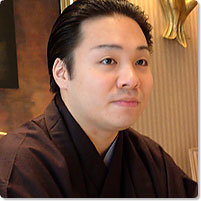
Kanjuro Fujima
Born in 1980, Kanjuro Fujima is a Kabuki furitsuke-shi (choreographer). He is the head of the Fujima school of traditional Japanese dance ( Nihon buyo ). His grandfather, Kanjuro Fujima IV was the highly acclaimed choreographer and dancer who was eventually designated a “Living National Treasure” by the Japanese government and whose oeuvre included a large number work. His mother Kanso Fujima III, is also a currently active Kabuki dance furitsuke-shi . In 2002 at the age of 22, he succeeded to the Kanjuro name, becoming Kanjuro Fujima VIII. He is winner of the 2003 New Artist award Minister of Education and Science Award for the Arts. He is known for his many new choreographic works, such as for the Imamukashi Momotaro performance for Nakamura Kanzaburo’s Name Succession performance in December 2004.
Interviewer: Kazumi Narabe
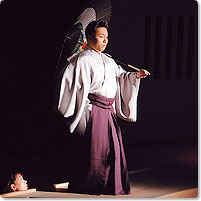
Buyo Tokiwazu; Masakado
(at Ishikawa Ongakudo Hougaku Hall, 2004)
Photo: Reiji Yamada
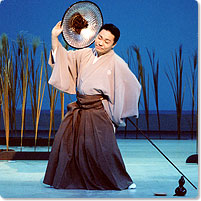
Nagauta; Tsukimi-zato
(at National Theatre [Small Theatre], 2003)
Photo: Reiji Yamada
